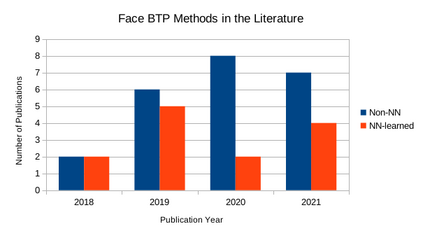This paper presents a survey of biometric template protection (BTP) methods for securing face templates in neural-network-based face recognition systems. The BTP methods are categorised into two types: Non-NN and NN-learned. Non-NN methods use a neural network (NN) as a feature extractor, but the BTP part is based on a non-NN algorithm applied at image-level or feature-level. In contrast, NN-learned methods specifically employ a NN to learn a protected template from the unprotected face image/features. We present examples of Non-NN and NN-learned face BTP methods from the literature, along with a discussion of the two categories' comparative strengths and weaknesses. We also investigate the techniques used to evaluate these BTP methods, in terms of the three most common criteria: recognition accuracy, irreversibility, and renewability/unlinkability. As expected, the recognition accuracy of protected face recognition systems is generally evaluated using the same (empirical) techniques employed for evaluating standard (unprotected) biometric systems. On the contrary, most irreversibility and renewability/unlinkability evaluations are based on theoretical assumptions/estimates or verbal implications, with no empirical validation in a practical face recognition context. So, we recommend a greater focus on empirical evaluation strategies, to provide more concrete insights into the irreversibility and renewability/unlinkability of face BTP methods in practice. An exploration of the reproducibility of the studied BTP works, in terms of the public availability of their implementation code and evaluation datasets/procedures, suggests that it would currently be difficult for the BTP community to faithfully replicate (and thus validate) most of the reported findings. So, we advocate for a push towards reproducibility, in the hope of furthering our understanding of the face BTP research field.
翻译:本文介绍了在神经网络面部识别系统中确保面部模板的生物鉴别模板保护方法(BTP)调查。BTP方法分为两类:非NN和NN-SB方法。非NN方法使用神经网络(NN)作为特征提取器,但BTP部分依据的是在图像级别或特征级别应用的非NN的算法。相比之下,NN-Spop方法具体使用NNN方法从无防护的面部图像/功能识别系统中学习一个受保护模板。我们从文献中举出了非NNN和NNNW的面部识别模板方法,同时讨论了两类的相对优势和弱点。我们还从三种最常见的标准(承认准确性、不可逆转性、更新性/不相连接性)的角度对BTP方法进行了评估。根据理论假设/更新方法,我们目前对真实性、更准确性、更准确性、更准确性、更准确性、更精确性、更精确性、更精确性、更精确性、更精确性、更精确性、更精确性、更精确性、更精确性、更精确性、更精确性、更精确性、更精确性、更精确性评估的实地的实地的实地评估,我们报告、更精确性、更能、更精确性、更精确性、更精确性、更精确性、更精确性、更精确性、更精确性、更精确性、更精确性、更精确性、更精确性、更精确性、更精确性、更精确性、更精确性、更精确性、更精确性、更精确性、更精确性、更精确性、更精确性、更精确性、更精确性、更精确性、更精确性、更精确性、更精确的实地评估、更精确性、更精确性、更精确的实地的实地评估、更精确的实地评估、更精确的实地评估、更精确的实地的实地评估、更精确的实地评估、更精确的实地评估、更精确的实地评估、更精确性、更精确性、更精确性、更精确性、更精确性、更精确性、更精确性、更精确性、更精确性、更精确性、更精确性、更精确性、更精确性、更精确性、更精确性、更精确性、更精确性、更精确性、更精确性







